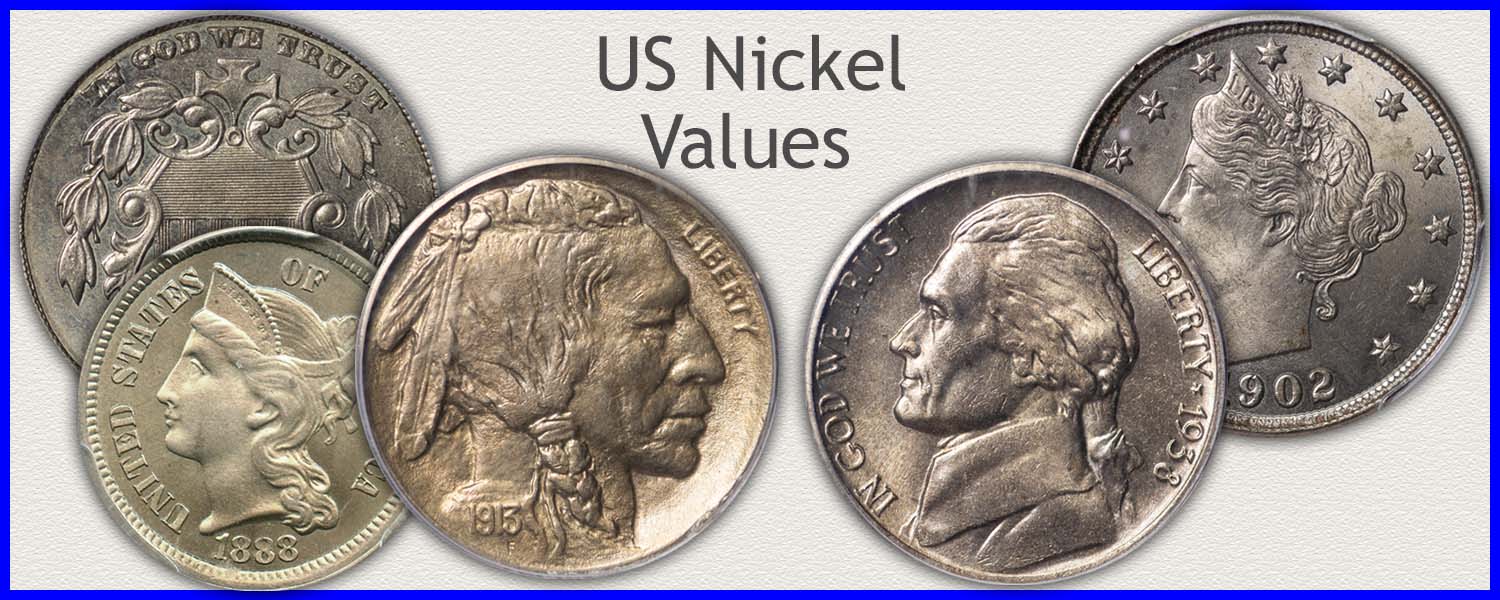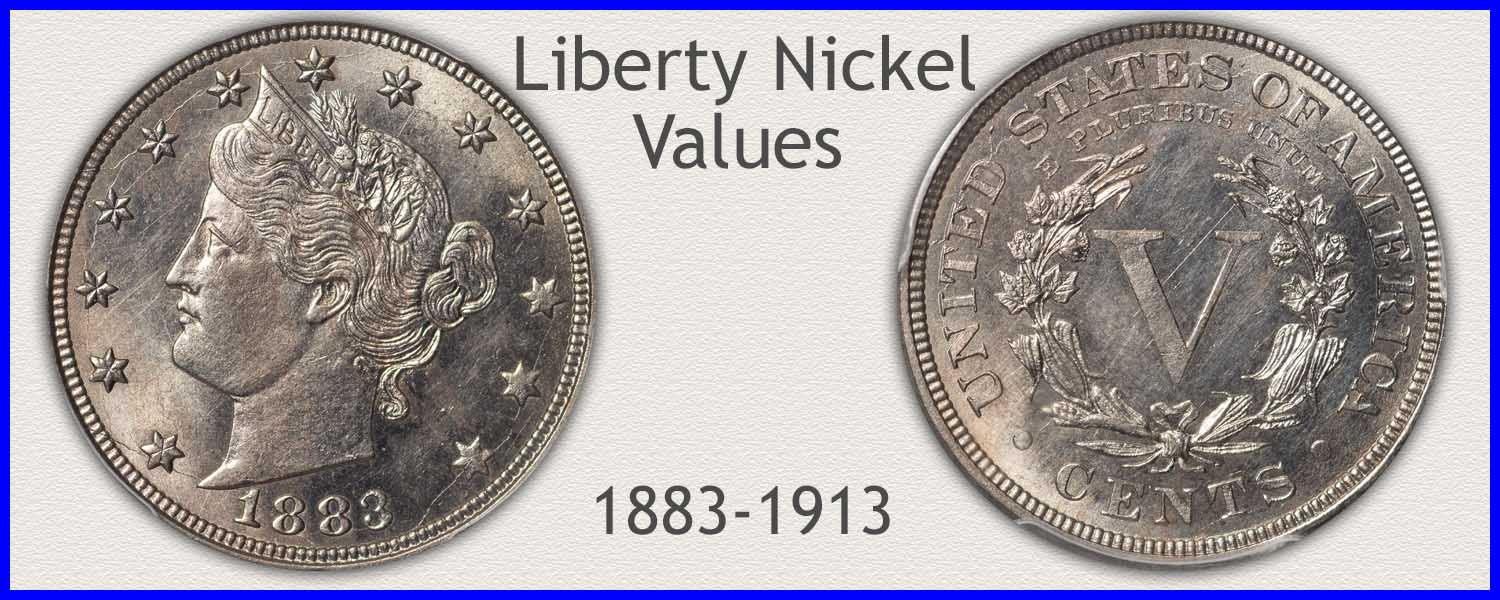Coin Values Moving with Precious Metals: Up-Dated 4/21/2025: Gold $3380 | Silver $32.89
1894 Nickel Value
1894 nickel value, as shown on the chart, is based on strong fundamental qualities. The coin market rewards scarce coinage with high minimum premiums. These older nickels represent a special status that draws attention, creating demand.
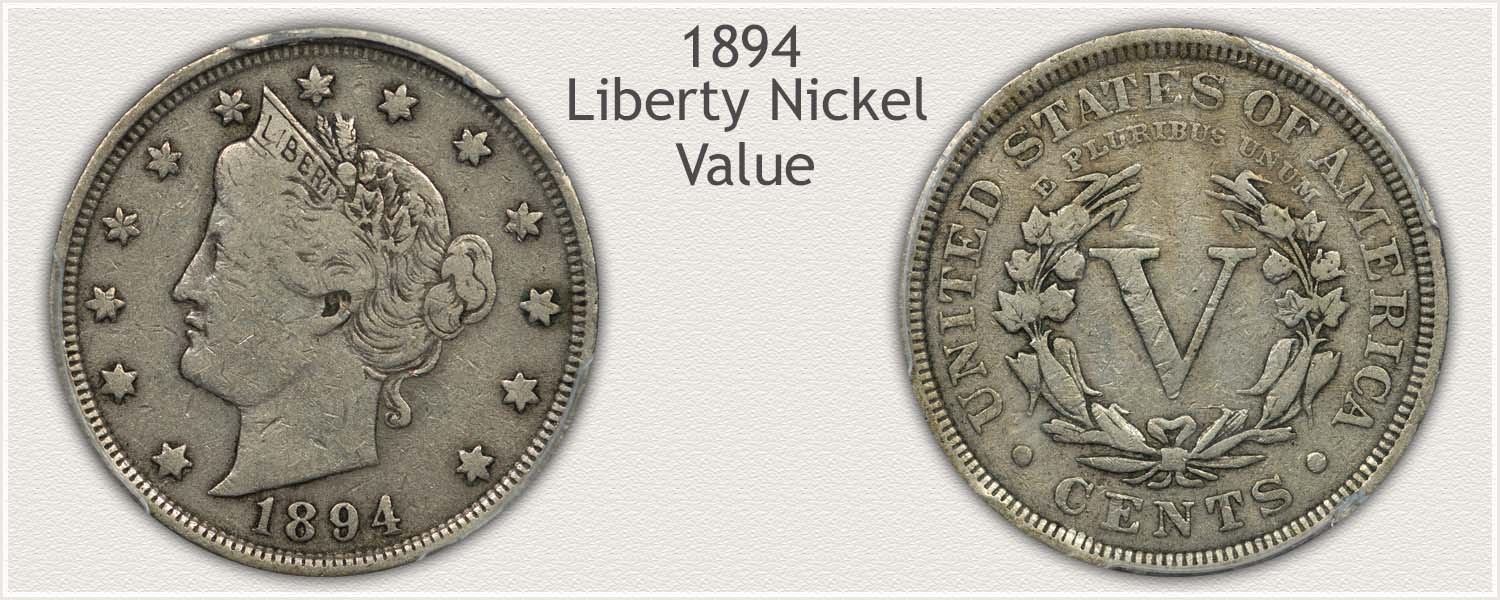
A full evaluation of old coins covers certain key elements. Images confirm the nickel series and year of issue. The important part of recognizing condition, a strong factor to value, is how to judge amounts of wear and overall state of preservation. Within the popular Liberty design series, 1894 nickels are rated in value based on their eye appeal status. Proceed through the steps to enjoy this important coin.
Steps Leading to Value:
- Step 1: Date Identified - An uncommon issue of the Liberty series, confirming the date 1894 finds a high demand coin.
- Step 2: Grading Condition - Images and descriptions present how to judge the quality of preservation and appeal, necessary to a full evaluation.
- Step 3: Special Qualities - Fundamentals of rarity are recognized and appreciated by the collectible market, helping determine worth.
| 1894 Nickel Value | ||||
|---|---|---|---|---|
| Condition of Coin | ||||
| Date | Good | Fine | Extremely Fine |
Mint State |
| Liberty Nickel Value Updated | 2024 | |||
| 1894 | $11 | $83 | $148 | $273 |
A narrow range of Wholesale values are listed on the chart. Using these as a guide is a conservative approach taking into the variances in the market. Dealer's demands and overall eye appeal contribute to a final worth.
Step 1: Date Identified and Accurately Recorded
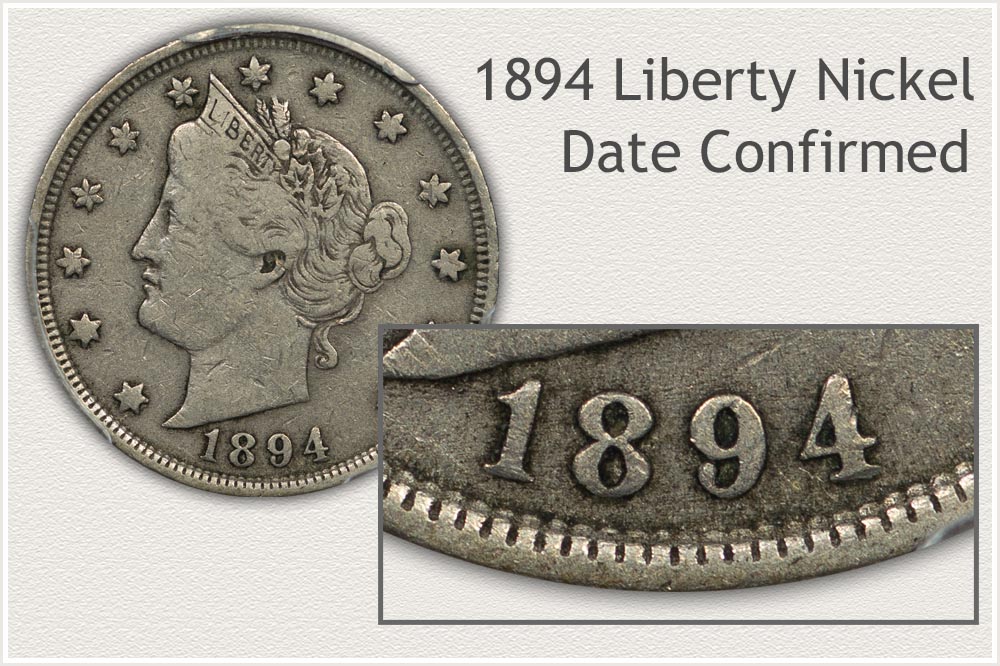
All 1894 nickels were struck at the Philadelphia mint. Minor coinage was typically handled by the facility. Decisions at the time by the mint to restrict production led to a distinctly lower than average mintage of these now scarce nickels. A sharp reduction to just 5.4 million coined went on to become the fourth lowest of the Liberty design series. Because of the importance of the coin, a second confirming inspection is needed.
Step 2: | Judge Condition Finding an Acceptable Grade
1894 Nickel Value is Conditional
State of preservation is becoming an important issue determining the accurate description and value of these nickels. With the different premiums shown on the chart, grading condition identifies its position. Comparing to images representing stages of wear and grades is a reliable approach in how to narrow both condition and grade ranges. Because of potential worth involved, it is recommended to hold each coin by the edges at all times. Careful not to damage the coin is also important to maintaining its quality.
Match the coin to an image of similar appearance. Continue with inspecting and judging the features highlighted in the descriptions of the standard grades. Liberty's portrait, details within, and overall impression of each coin is evaluated.
Mint State Grade
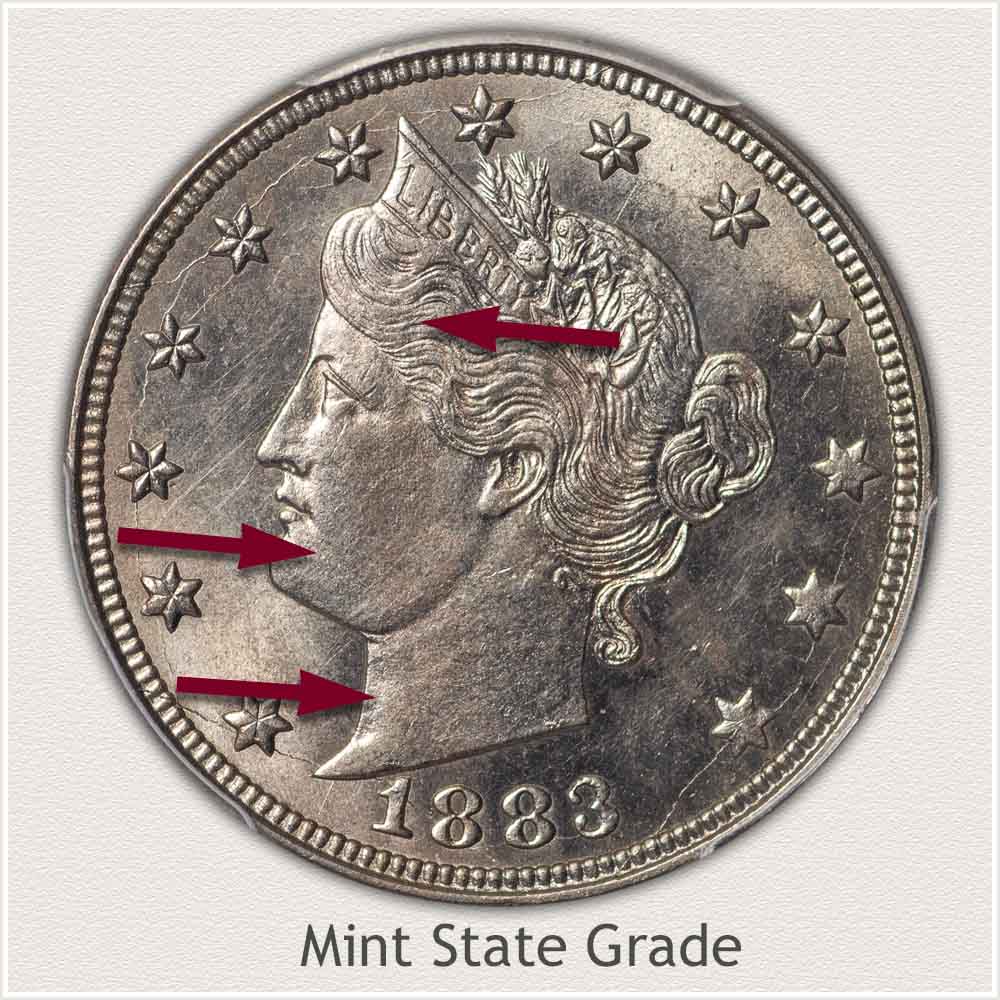
Mint State: Mint State grade is reserved for coins free of any wear to the surface. The "no wear" element is key to defining and determining this high-quality condition. A very finely detailed portrait of Liberty is the bold feature of the nickel. High areas are first inspected to judge confirming wear is absent.
Starting with Liberty's cheek and neck, a surface covered with a texture reflecting a luster indicates undisturbed metal. Nickel when worn losses the delicate minting texture, becomes a smooth surface, and turning a muted gray color. Toning to a light tan often covers these open cheek and neck areas, it is the lack of smoothness to the metal helping to decide. When compared to lower relief portions along the neck line a similarity of surfaces helps in judgement of wear.
Second areas to inspect are the finely detail strands of hair along her forehead. Highest points are fully rounded, no signs of flattened, worn surfaces. Delicate luster convers each strand both on the forehead and at the top of her head. Tilting the coin under a light confirms luster "beneath" any toning and is visible as brightness following movement of the light.
Extremely Fine Grade
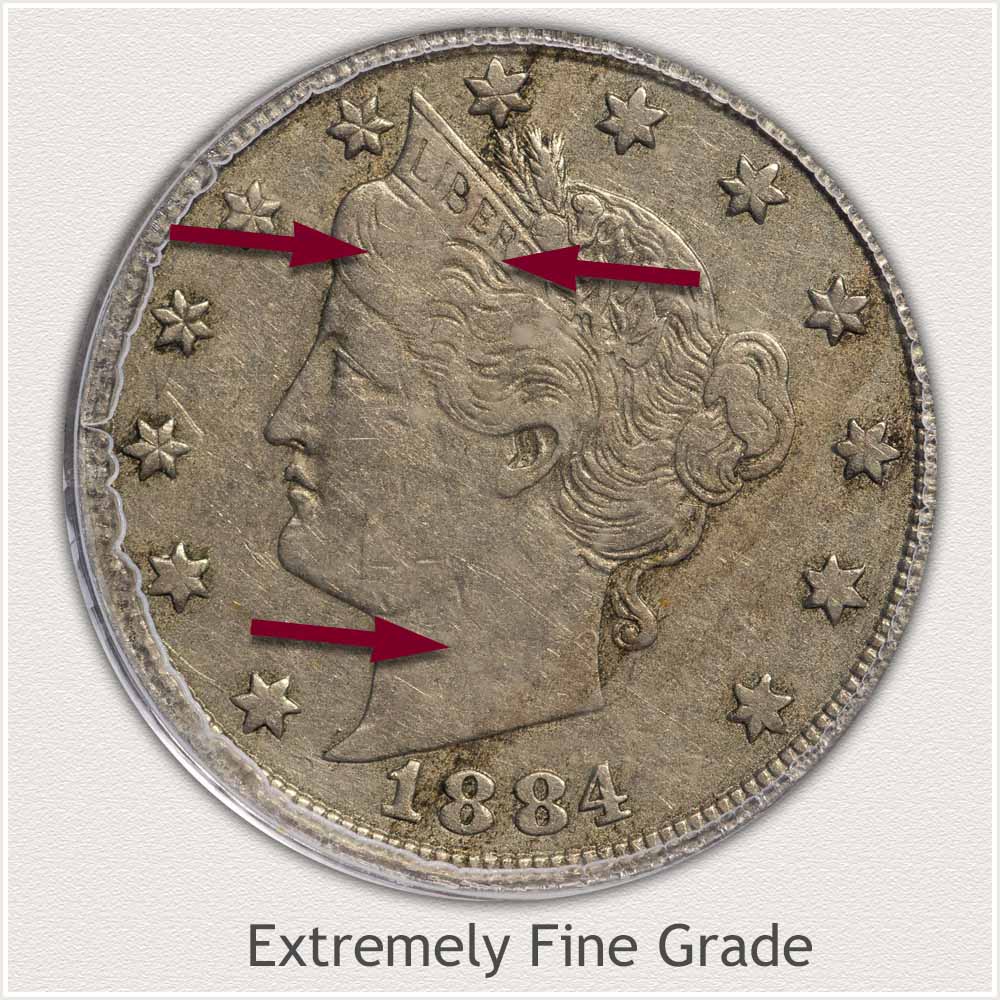
Extremely Fine: Showing just minor evidence of circulation wear are nickels in Extremely Fine grade. Helping define the condition is wear restricted to high points only. A nicely detailed coin is the first impression of a well-preserved nickel. Detecting the level and severity of wear begins with a close judgment of fine hair strands.
Just above Liberty's eye and within the hair, a small worn area has developed. This area of flatness connects the hair line at her forehead in a narrow zone to the headband. Important is no widespread merging of hair is seen. Any flatness is disconnected and minor.
A smooth surface now covers the open areas of her face and neck. Overall, a soft gray undertone is now the color to the nickel. With ample fine detail above the headband, showing grains of wheat and cotton leaves, a nice crisp look is displayed.
Fine Grade
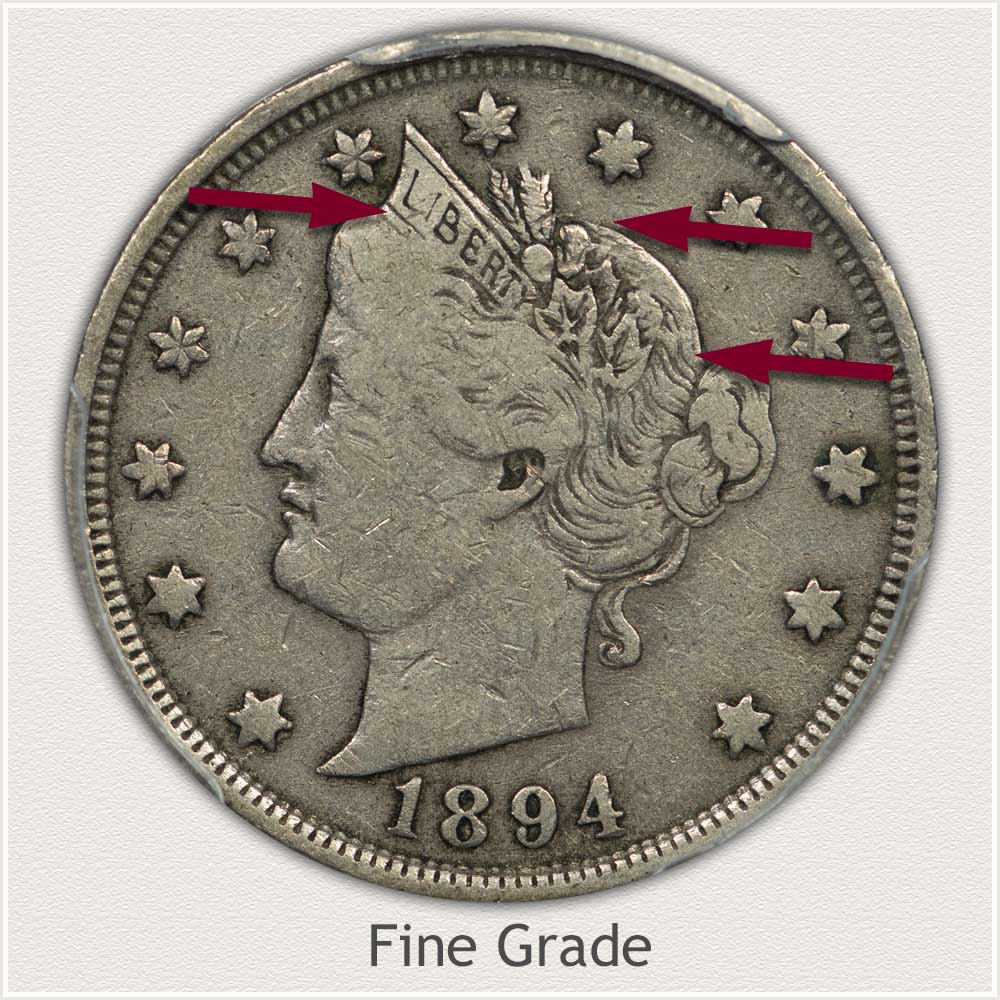
Fine Grade: Well within the collectible category, this 1894 nickel displays strong details and qualifies for the Fine Grade status. A nice balance of moderate wear offset by ample detail is defining the condition.
Remaining well detailed are the deeply recesses elements above Liberty's headband. Cotton bolls and leaves are easily recognizable, along with the wheat grains rising above her head. Combined with many hair strands defined, all lend a quality look to the design.
Important and necessary is full lettering to "LIBERTY" found within the headband. Although the lower edge of the band is missing or faint in areas, the upper line of the band is strong and complete. Slight detail indicating a separation of the hair at her forehead places the coin well within the grade.
Good Grade
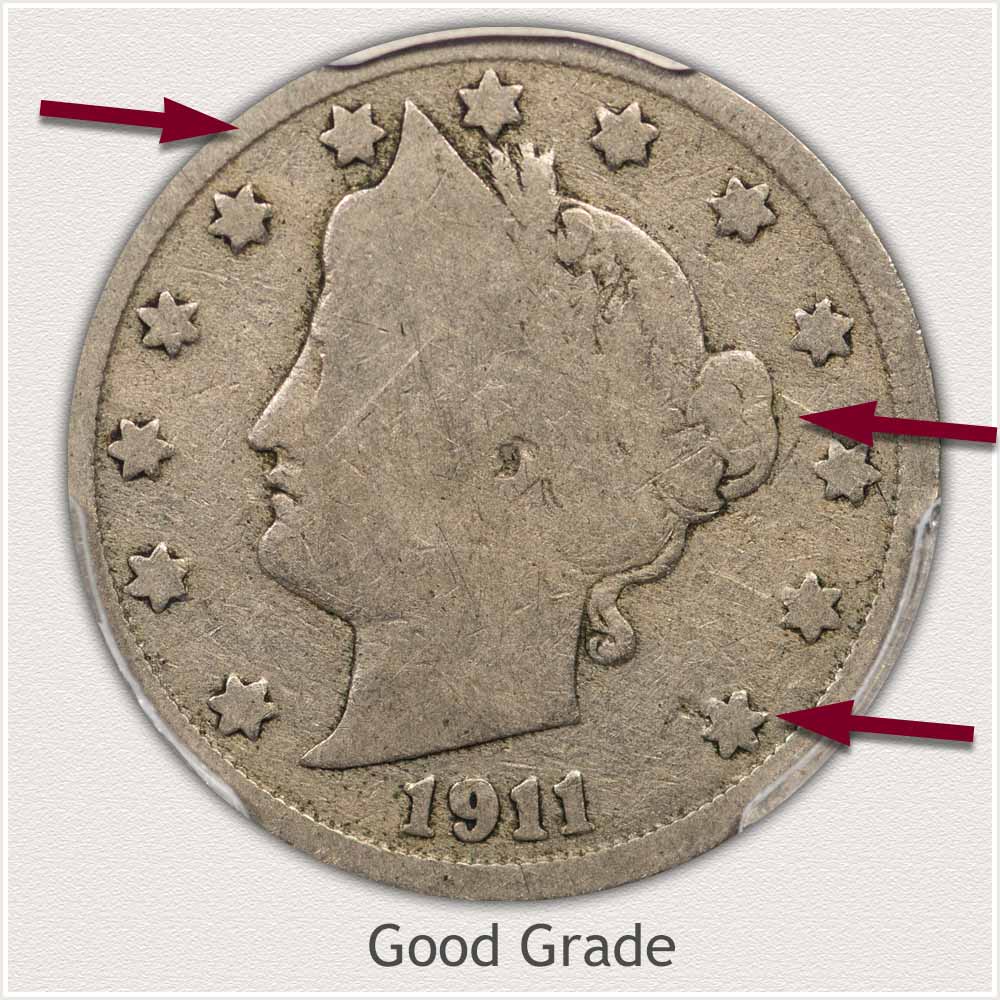
Good Grade: A smooth outline of Liberty's portrait is now the outstanding feature of a well-worn nickel. Judging the proper grade requires all outlines of major features are complete. Portrait, stars, date, and rim are full.
Liberty although well-worn, with few visible details, does remain fully and nicely bold of the field. Weakness and blending with the field is inspected closely, typically at the back of her head. The stars are all raised and complete, some bolder than others is often the case. A bold date completely legible and separate of the rim is required. Also, a strong requirement is the inner edge of the rim is complete. A Liberty nickel with just honest, but heavy wear still retains an appeal. The lack of soft areas of fading and blending adds a nice quality to this design.
How to Video: Grading Liberty Nickels
Subtle details are often the difference between levels of preservation. The standards used to determine condition and how to identify a grade are highlighted in the video specific to Liberty Nickels.
Grading Liberty Nickels | How to Video and Descriptions
Step 3: | Special Qualities | Scarcity Insights
Where are all the 1894 Nickels?
During the 1890s, commerce relied on hand-to-hand transfers of money for everyday purchases. Coinage provided an important role, coins such as nickels were carried in pockets and coin purses. From the general store to the soda fountain, transactions involved coinage.
A robust economy and growing population required the U.S. mint to provide the needed coinage, avoiding any shortages.
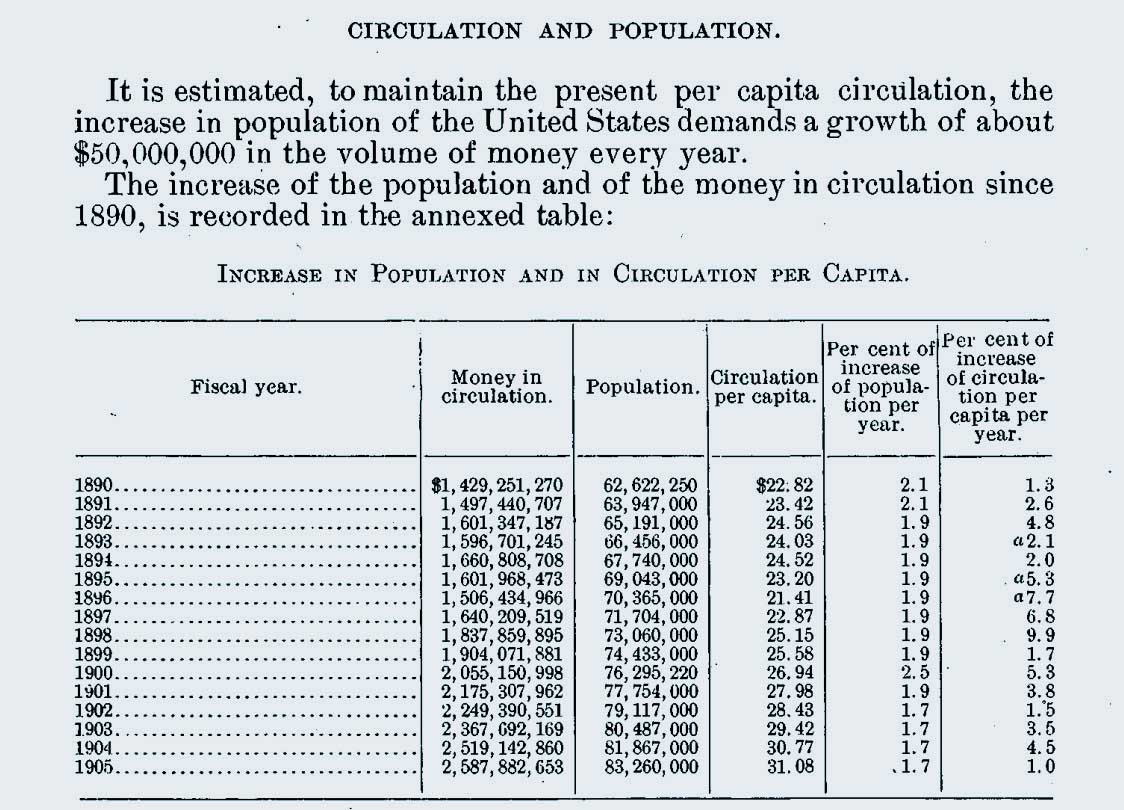
However, in 1894, on hand stocks of minor coinage were ample due to the prior year's production, for example, 1893 nickels totaled over 13 million coins. The following excerpt from the 1894 Mint Report shows the action taken resulted in a large decrease in the numbers of nickels produced for the year.
"The stock of 5-cent nickel pieces in the several subtreasuries wouldbe ample to meet the requirements for some time. The coinage of both the 1 -cent bronze pieces and the 5 -cent nickel pieces was therefore suspended in April, 1894."
Stopping production in April resulted in a mintage of 1894 nickels, ending the year at 5.4 million pieces. This went on to become a well below average coinage year of the Liberty series.
Usage in circulation now begins to reduce an already lower than normal mintage. Nickels were an important denomination at the time, many were used during transactions. As an active coin, they saw continued use for decades. As time passed, heavy wear was typical for their condition.
Further reduction in existing numbers of 1894 nickels is due to the handling of "unfit" coinage. Part of the operations of the main mint in Philadelphia was the processing of "uncurrent" and "unfit" domestic coinage. Old coins, damaged, worn, and considered unfit for use were routinely remelted.
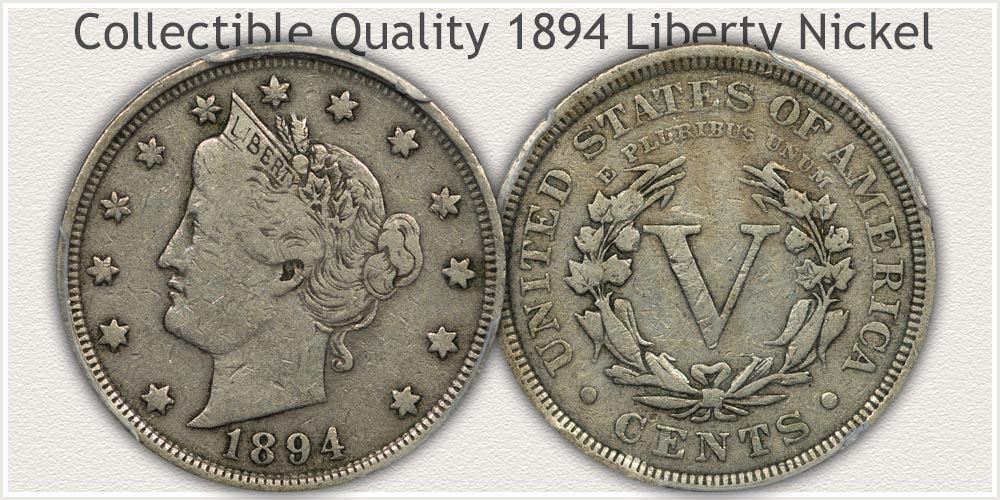
Twenty years on from 1894, the new design Buffalo nickel was now introduced and began widespread circulation. Older Liberty nickels were moving out of circulation. By 1913-14, millions of these older nickels were melted for recoinage. This is a normal part of minting operations. Retiring worn, uncurrent coins and reminting for new. Just after the ending of the Liberty series, the few years listed represents the scale of a continuous yearly remelting operation.
- Unfit Coinage Returned and remelted
- 2,170,421 Older Unfit Nickels Melted in 1911
- 1,608,000 Older Unfit Nickels Melted in 1912
- 11,457,580 Older Unfit Nickels Melted in 1913
Today, scarcity of 1894 nickels is reflected in premiums listed on the value chart. These coins started with a built-in scarce factor of low production. Add in the heavy usage of the important 5 Cent denomination, and standard operations of melting older coinage. 1894 nickels rapidly diminished in numbers over time. Those remaining are the result of sporadic saving, becoming keepsakes when found among Buffalo nickels.
Pleasing examples of scarce coinage are in strong demand by the coin market.
References
U.S. Mint. 1895 U.S. Mint Annual Report
https://nnp.wustl.edu/library/book/514117
U.S. Treasury. Annual Report Secretary of the Treasury 1905
https://fraser.stlouisfed.org/title/194/item/5551
U.S. Mint. 1914 U.S. Mint Annual Report
https://nnp.wustl.edu/library/book/514127
U.S. Mint. 1913 U.S. Mint Annual Report
https://nnp.wustl.edu/library/book/514126
U.S. Mint. 1912 U.S. Mint Annual Report
https://nnp.wustl.edu/library/book/324
U.S. Mint. Catalogue of Coins of the United States.
https://nnp.wustl.edu/library/book/554591
Coin Values | CoinStudy Articles
Date by Date
In Depth Liberty Nickel Values
1883 to 1912
Old Nickel Values | Guide to the Different Nickel Series
Many different design series of nickels span the centuries, beginning in 1866. Identify the exact coin, important and scarce dates, and reference value charts of these popular collectibles.
The Value of V Nickels | Common to Very Rare Liberty Nickels
Value chart listing all dates. A nickel series gaining in popularity causing all dates and mints to rise in value. The Liberty design series began in 1883 and any date minted in the first decade is a premium coin an all grades.
1894 nickels are one of the scarce dates and varieties of older nickels. Many different series of nickels are part of U.S. coinage. Among these are certain stand-out dates, popular mint varieties, and those rarely found in pleasing condition. Many are highlighted and worth identifying.
Coin Grading Services | Professional Judgment of Authenticity and Grade
Often having these higher value coins evaluated and grading by one of the top two services improves their market acceptance. With the steep rise in value moving up the grading scale of 1894 nickels, any coin worth over one hundred dollars is a candidate. Review the services helping to decide.
★Coin Values Discovery finds 1894 Nickel Value and...
A step-by-step process discovers all U.S. coin values. Images identify the different series of coins covering all denomination from cents through gold coinage. Each is further detailed with important elements and features key to a complete and accurate to worth. A box of old coins has potential.
